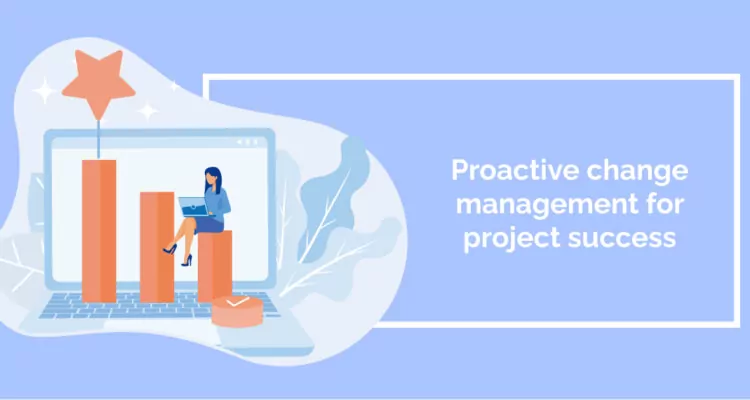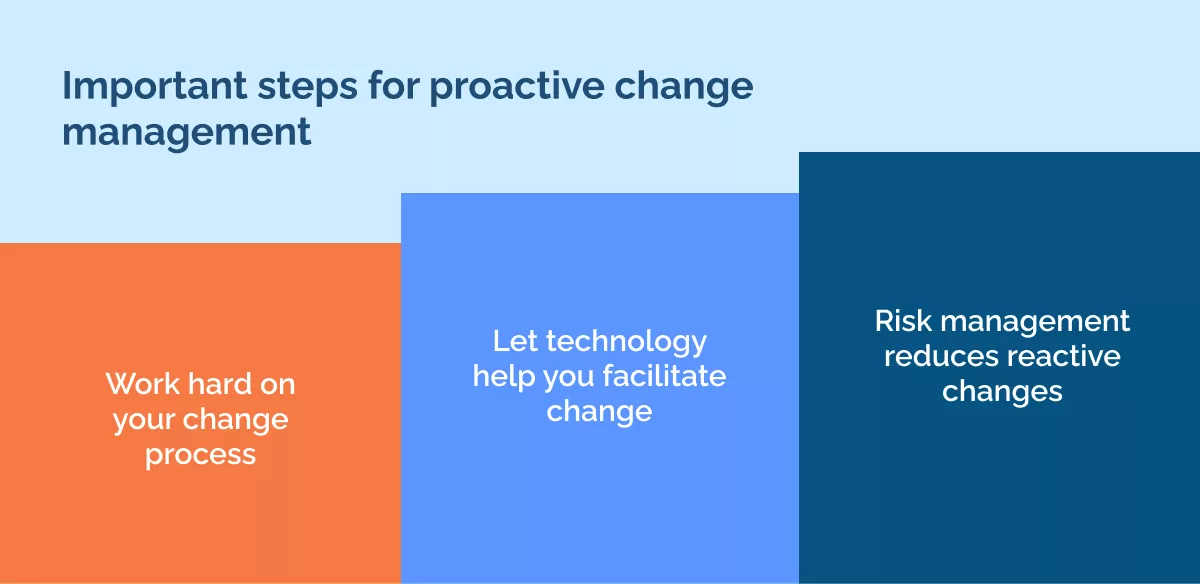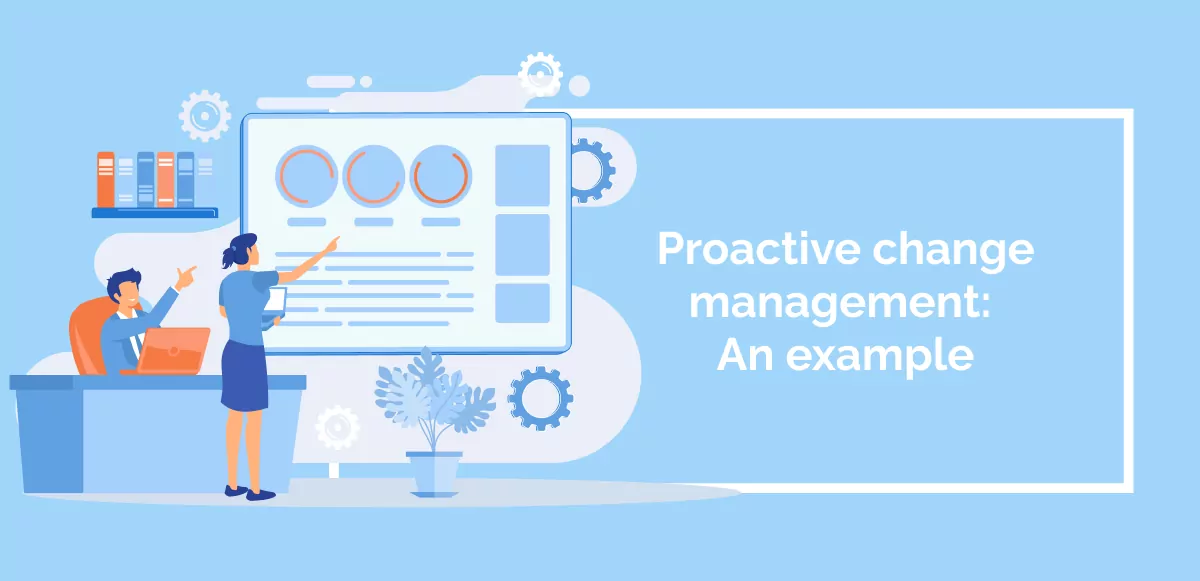
Proactive change management happens when leaders actively seek to manage the challenges and opportunities in a change project. Every change project comes with many unpredictable aspects. A proactive change manager will plan for every problem. They will also create contingency plans for unexpected challenges.
Any serious change management project should be led by proactive decisions if you have decided to introduce change reactively – good luck! Of course, there will be unexpected problems, and good leaders will react appropriately. But by approaching change projects proactively, you can make your processes much more efficient.
This article will help introduce you to the challenges and opportunities of proactive change management. We will:
- Define proactive change management
- Compare proactive and reactive change management
- Explain some of the key steps to create a proactive change change management process
- Introduce an example of proactive change management in action.
A proactive approach to change doesn’t mean you won’t experience problems. It just means that you will be better prepared to meet them.
What is proactive change management?
Proactive change management means that change leaders anticipate change management problems before they arise. It is a valuable aspect of proactive leadership or proactive management, in which strategic planning, risk management, and contingency sequences are a priority.
In some senses, the whole discipline of “change management” itself can be described as “proactive.” After all, if you are using any theory of change, you’re already trying to predict, understand, and prepare for all the problems in the way of a new state of change. In many cases, you behave proactively as soon as you use a credible theory of organizational development or the latest research into change management.
However, some change models are especially well-adapted to handle the unpredictable issues that arise in development or implementation. In software and technology, the Capability Maturity Model (CMM) is especially adept at modeling the different levels of changes and reactions necessary for creating a product.
More generally, agile change management is great for proactively planning for unexpected challenges.
All the same, reactive change management is not the bad guy here. It’s still an important part of leadership during change, as explained in the next section.
Proactive change management and reactive change management – what’s the difference?
Proactive and reactive change management: It’s not a case of good vs. evil or different schools of thought. They’re two sides of the same coin. A major change management project will always involve careful planning – but it will also include surprises. A good change manager will plan for what they can – but handle what they can’t.
Proactive change management involves planning and preparing for changes in advance as part of a strategic vision, aiming for less disruption and lower resistance. In contrast, reactive change management responds to immediate issues or crises that have already arisen, often resulting in hasty, disruptive adjustments and a higher risk of employee resistance.
In a classic conference paper from 2005, Liam Dillon explains how reactive change management can work. It seems paradoxical, but “there is sometimes a need to react positively and systematically to the unplanned.”
In any change project, reactive strategies should be part of your proactive change management plans.
Important steps for proactive change management

To put this simply, good change management is almost always proactive change management. We can’t say that every aspect of change management is strictly proactive. But they take you a long way towards your organizational goals.
This section will introduce three of the most important steps for achieving proactive change practices in 2023. First, work on your change process; second, make a thorough risk assessment; and third, introduce appropriate technology.
Work hard on your change process
Any proactive change management project should thoroughly investigate the best change management process for your organizational change.
Different change initiatives require tailored approaches, and choosing the right process ensures that resources, strategies, and timelines align with the specific needs and objectives of the change. Whether it’s Lewin’s model, Kotter’s eight-step framework, or another methodology, a well-informed decision on the change management process empowers organizations to plan, execute, and monitor change in a structured and proactive manner.
A good change process enhances efficiency and minimizes the risks associated with change by providing a clear roadmap for success.
Let technology help you facilitate change
Technology is pivotal in proactive change management by facilitating efficient communication, data analysis, and collaboration.
Modern software enables organizations to gather real-time information, track progress, and identify potential areas of concern early on. Technology tools such as project management software, data analytics platforms, and communication tools help streamline the planning and execution of change initiatives, making it easier to engage with stakeholders, monitor key performance indicators, and adapt strategies as needed.
By leveraging technology, businesses can proactively stay ahead of challenges, enhance decision-making, and drive successful change management processes.
Risk management reduces reactive changes
Risk assessment is a crucial step in proactive change management because it helps organizations identify potential challenges and obstacles that may hinder the success of a change initiative. Businesses can develop strategies to mitigate these risks by systematically evaluating them, ensuring a smoother transition.
A proactive approach to risk reduces the likelihood of costly disruptions. It helps the organization to allocate resources more effectively, enhance employee buy-in, and ultimately increase the chances of a successful change implementation.
Diligent risk assessment can contradict “common sense.” A 2022 Gartner report illustrated clearly how perceived and actual risks differed. The most common risk companies faced was compliance, experienced by 22% of companies – but only 10% anticipated it successfully.
Risk assessment may turn out to be very technical. So, ensure you have the industry-specific expertise to help meet your needs.
Proactive change management: An example

So – what does proactive change management look like?
By now, you should have a few ideas. But there’s nothing like clear examples of change management to really understand how to do it! So, let’s dive into an example. This is completely fictional. But it clearly illustrates the issues at stake with proactivity in a digital transformation project.
The situation: software implementation
A company wants to adopt a new ERP system to improve overall organizational efficiency. It’s a big change project. But the company’s leadership team can see that there will be major benefits. Fortunately, the IT leadership team is also supportive of the implementation.
Everyone knows there will be some “teething problems” along the way. But let’s see how a proactive or reactive approach can significantly affect the outcomes.
Scenario 1: Reactive management for project change
In consultation with senior leadership, the team leading change decided to implement the software across the company at the same time. They organize a great set of specialized training seminars so staff can get up to speed with the new processes. They provide clear documentation for many core processes. Of course, the change managers expect that there will be problems – but they think they’ve done enough work to handle any issues reactively.
Things start well when the day of the ERP’s “big bang” comes. But after a couple of weeks, problems emerge. For example:
- Employees know how to complete most of the key processes in their areas. However, every process takes a lot more time. After all – the system is new, and staff are still getting used to it.
- Now and then, an employee finds that there’s an important process that they don’t know how to do. There is a method for escalating those inquiries, but the support staff are inundated with problems.
- From time to time, there are unexpected problems with data transfer in various departments. These only become obvious two or three weeks after the ERP was implemented.
As a result, many simple actions are suddenly quite difficult. Onboarding a new staff member, paying invoices, and sharing customer data between departments are now time-consuming tasks. All of these problems can be fixed. And in time, the company achieved many of the planned efficiencies.
However, it’s taken them a long time to achieve the ROI of the change project. They’ve spent a lot more money – and annoyed their staff along the way.
How could a proactive approach help in the same situation?
Scenario 2: Proactive planning in action
Another company decided to implement a wide-ranging ERP system. They also implemented extensive training – just as in scenario 1.
But on top of these plans, upper management commissioned a detailed risk assessment. After a full analysis of their business processes, they were excited to see that they could automate and optimize many routine tasks.
They added a few more tasks to proactively prepare for an efficient introduction of the new software.
- They adapted a widely-used change model to their specific situations.
- Used a Digital Adoption Platform (or DAP) to create custom workflows and tailor-made contextual help
- Decided on a staged roll-out of the software implementation. Overall, they planned to introduce the system over 3 months.
- Established clear KPIs for adoption, use, and help center requests – and made sure they could track them
- Prepared a specialized team of developers, consultants, and area specialists to report on and respond to problems as they arose.
The outcome wasn’t perfect – it never is! Every department found small problems in the days and weeks after they had the software update. However, through the change team, each business unit shared its concerns, received feedback, and often helped to anticipate issues for other departments. Most importantly, their DAP and staged roll-out made it easy to update training materials effectively.
In both scenarios, leaders knew they would face planned and unplanned challenges. In scenario 1, the change leaders assumed they could reactively handle the arising problems. By contrast, the leaders of scenario 2 made no assumptions about their capabilities – they took steps to ensure that no stone was left unturned.
Thoughts for the future of strategic planning
Proactive change management is the heartbeat of organizational resilience. Embracing problems before they become urgent empowers us to shape our future, seize opportunities, and stay ahead in a dynamic world. The path to lasting success is not merely reacting to change but proactively leading it, for therein lies the power to transform challenges into triumphs.
A good change manager can plan for the worst, hope for the best, and deal creatively with the unpredictable outcomes of an implementation project. With proactive steps, you have a much better chance of succeeding with the reactive surprises.
WalkMe Team
WalkMe spearheaded the Digital Adoption Platform (DAP) for associations to use the maximum capacity of their advanced resources. Utilizing man-made consciousness, AI, and context-oriented direction, WalkMe adds a powerful UI layer to raise the computerized proficiency, everything being equal.



